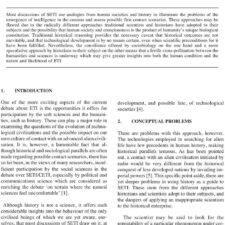Quantifying the Fermi Paradox in the Local Solar Neighbourhood
£5.00
D. Cartin (2014), JBIS, 67, pp.119-126
Refcode: 2014.67.119
Keywords: Fermi paradox, Percolation theory, Solar neighbourhood
Abstract:
The Fermi paradox highlights the dichotomy between the lack of physical contact with other civilizations and the expectation that technological civilizations are assumed likely to evolve in many locations in the Milky Way galaxy, given the large number of planetary systems within this galaxy. Work by Landis and others has modeled this question in terms of percolation theory and cellular automata, using this method to parametrize our ignorance about possible other civilizations as a function of the probability of one system to colonize another, and the maximum number of systems reachable from each starting location (i.e. the degree in the network used for percolation). These models used a fixed lattice of sites to represent a stellar region, so the degree of all sites were identical. In this paper, the question is examined again, but instead of using a pre-determined lattice, the actual physical positions of all known star systems within 40 parsecs of the Solar System are used as percolation sites; in addition, the number of sites accessible for further colonization from a given system is determined by a choice of maximum distance such efforts can travel across. The resulting simulations show that extraterrestrial colonization efforts may reach the Solar System, but only for certain values of the maximum travel distance and probability of an occupied system further colonizing other systems. Indeed, large numbers of systems may be colonized with either vessels that lack insufficient travel distance to reach the Solar System or else have a colonization probability where they are statistically unlikely to reach us.





